Taking Measure
Just a Standard Blog
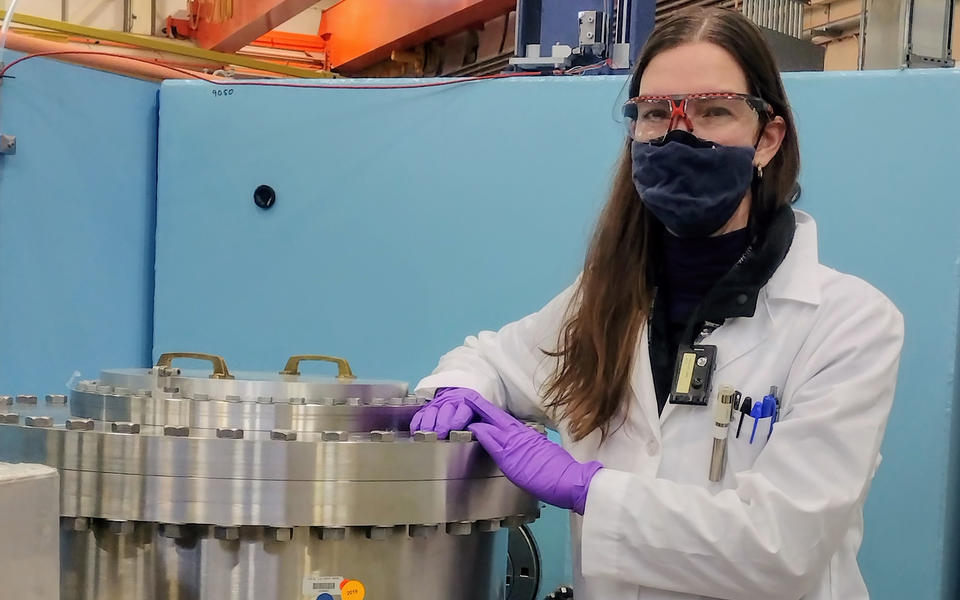
With the neutron depth profiling instrument.
The first five minutes of any presentation I give on neutron depth profiling are usually met with blank stares from my audience. This, I hope, is not something about me, but rather due to the audience’s lack of familiarity with the topic. Neutron depth profiling, which is always shortened to NDP, is a little-known technique that belongs to the rarefied field of radiochemistry. In recent decades, general scientific familiarity with radiochemistry and associated analytical methods has dwindled to near non-existent levels as it is now rarely taught in undergraduate science courses. Case in point, during the introduction for a talk I was giving at a well-attended nuclear science conference three years ago, the organizer stopped mid-sentence after reading aloud that I was a radioanalytical chemist to point out to me (and the presumably attentive audience) that I was of a dying breed. Such comments do not give one confidence in one's career choices, but well illustrate the dearth of knowledge of the field within the broader nuclear research community. However, and despite its lack of notoriety, neutron depth profiling has and continues to be a relevant materials analysis technique that produces timely, high-impact results. In this post, I aim to convince you of the accuracy of these statements.
Before delving into its applications, it is useful to explain what NDP is and how it works. Bear with me, as this will require a little nuclear science. First, what is NDP? The definition I most often give is that it is a technique that uses neutrons to measure both the amount and physical distribution of select atomic elements in a material, without destroying the material. I will explain what this means with more detail below as we go over how NDP works. At its core, an NDP measurement depends on the reaction between a neutron and an isotope of an element. As my high school chemistry teacher used to say, “If atomic elements were cookies, then isotopes would be the flavor of the cookie.” Following this analogy, lithium (Li) would be the cookie and 6Li and 7Li would each be isotopic flavors of said cookie. Scientifically speaking, the difference between 6Li and 7Li isotopes is the number of neutrons held within an atom’s nucleus. To date, NDP works with only a handful of isotopes, 6Li being one of them and the most often measured others being 3He (an isotope of helium), 10B (of boron), and 14N (of nitrogen).
It is usually at this point in my NDP talks when an audience member will ask the all-too-familiar but very important question as to why they should care about this technique if it can only measure a few elements. Wouldn’t their (and by extension my) time be better spent learning about other instrumentation that can measure more of the periodic table? Well, while it is true that the pool of elements detectable by NDP is small, the elements it can measure are incredibly important to sustaining our modern lifestyles. For example, if it weren’t for boron, which was an essential component of early semiconductors, we would not have personal computers (like you are presumably using to read this post) or cell phones (which I hope you are not trying to use to read this). Likewise, Li is a well-known constituent of batteries, and can be an active medical ingredient. These elements are vital to many industries, and reliable, quantitative detection of their concentrations is necessary to sustain and advance our current civilization. And while there are other techniques that can measure these elements, none can do so across the dynamic concentration range achievable by NDP and do it in a way that doesn’t change or destroy the sample.
With that question answered and my second talk-induced career crisis averted, we can now return to learning the NDP reaction. This reaction occurs in three steps, which are depicted in figure 1. In step one a neutron will encounter one of the above listed isotopes. Neutrons are very penetrating, so they can produce reactions throughout the whole of a sample. Under the right conditions the neutron and isotope may react. Emphasis is on the word may here as these reactions do not occur 100% of the time. Rather, the likelihood of a reaction is isotope and condition specific. Is this because neutrons only like certain flavors of cookies? In terms of nuclear physics, the incomplete and tentative answer is yes, but deeper insight into that phenomenon will to be left to the textbooks. Because of this, not all isotopes, nor even one isotope of all elements, will react. However, and luckily for NDP, these other, insensible flavors won’t interfere with us enjoying the few cookie types that can be detected.
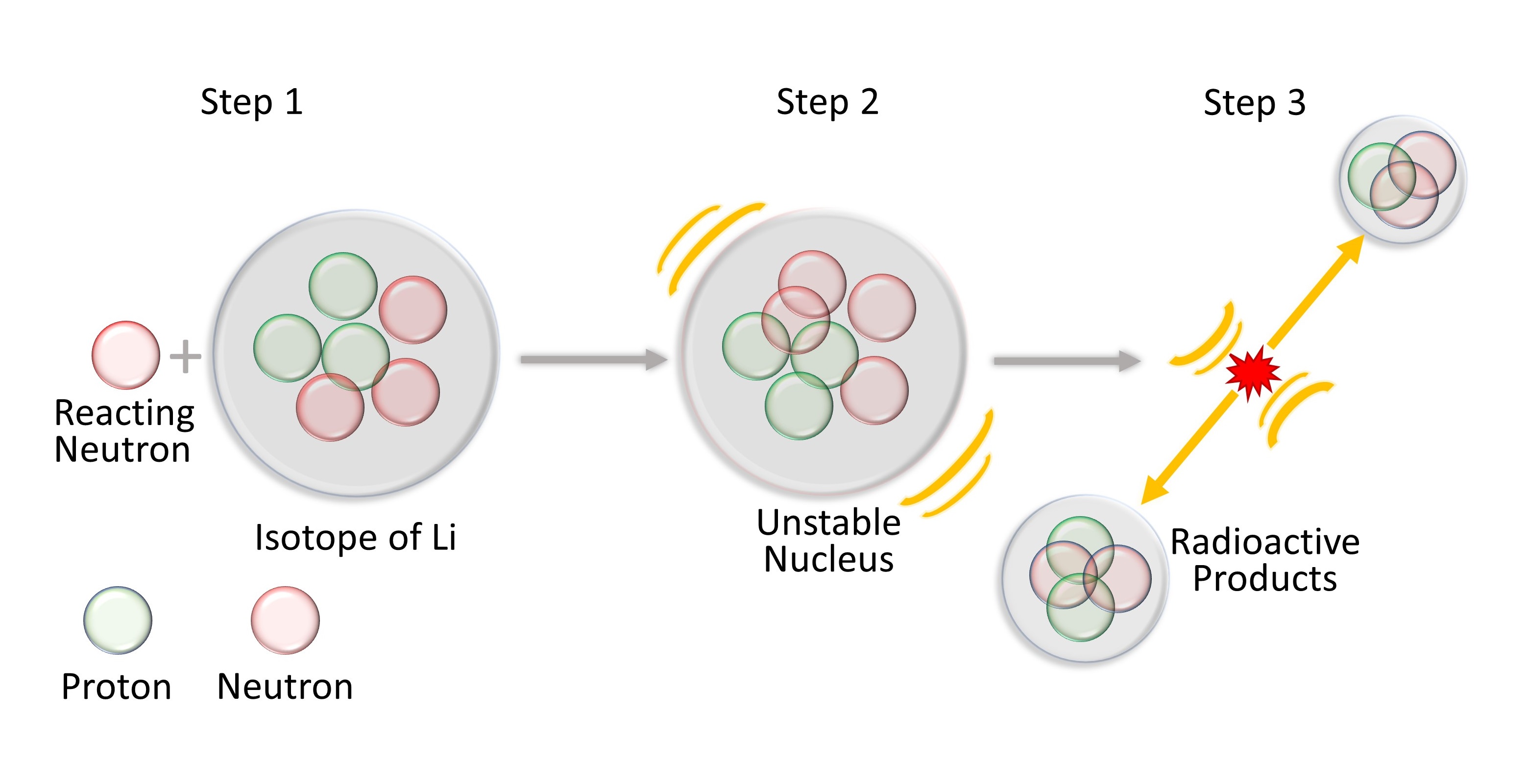
If the needed conditions are met, then the isotope will absorb the neutron to form a new, unstable entity called a compound nucleus (step two, figure 1). Like most things in the universe, this nucleus does not like being unstable. To become stable again it will energetically break apart, throwing off charged particles with specific initial energies in any direction (step three, figure 1). This is a dramatic process on the subatomic scale that can produce enough energy to push an ion very, very far. How far? One of the products from a Li neutron reaction can be thrown more than 10,000,000,000 times its diameter! This distance becomes much shorter when and depending on how often the ion interacts with other atoms along its path. When such engagements occur, the ion will predictably lose a set amount of energy. It is the ions produced and the energy they have remaining after passing through material that is measured in an NDP experiment and gives a cross-sectional snapshot of the isotope’s dispersion in a sample — aka a neutron depth profile (figure 2). Although it varies, profiles can be obtained from the first few tens of micrometers of a sample. Ions originating any deeper are stopped before they can exit the material.
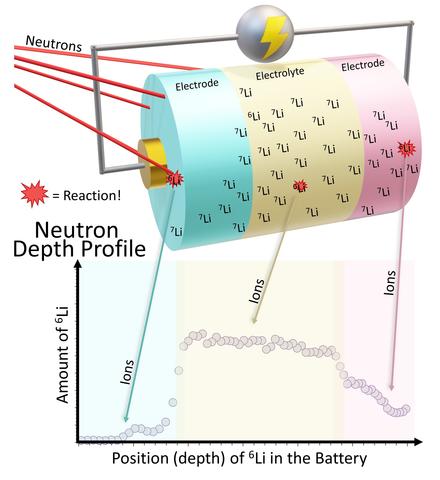
Like atomic elements, neutrons also come in a variety of flavors. To be nit-picky, the fundamental particles that make up neutrons also have “flavors,” but for the sake of keeping this post short this will be ignored. Here we will define neutron flavors by their energy, and they are either epithermal (high energy), thermal (intermediate energy — the same temperature as air molecules) or cold (low energy). At the National Institute of Standards and Technology (NIST) Center for Neutron Research (NCNR) where the NIST NDP is housed, cold neutrons are produced by passing thermal neutrons through a material that slows them down and reduces their overall energy. Using cold neutrons for NDP experiments is excellent as they increase the probability that a neutron will react with an isotope. Cold neutron experiments make collection of data on dynamically changing samples viable — a feature that has been key to the development of NDP Li-ion battery research capabilities at NIST.
NDP has a several decades-long history at NIST, and through all these research efforts the stage has been set for NDP to become one of the powerhouse tools for the analysis of Li-ion batteries. Due to its unique sensitivity to 6Li, the technique can be used to peek inside the internal workings of Li-ion cells in real time (figure 2). Issues such as low cell energy densities, slow charging, and short lifespans — all of which can afflict current consumer Li-ion batteries — can be identified and mitigated with the aid of NDP. The speed and accuracy to which they can be resolved will partially define the rate of future growth for the already $40.5 billion global Li-ion battery market.
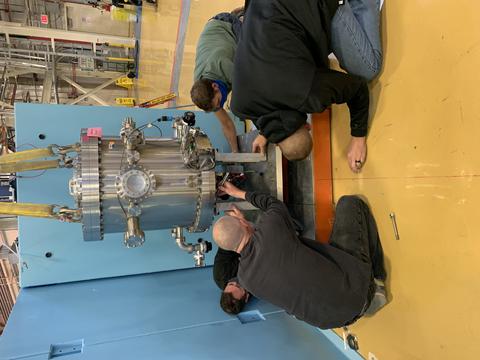
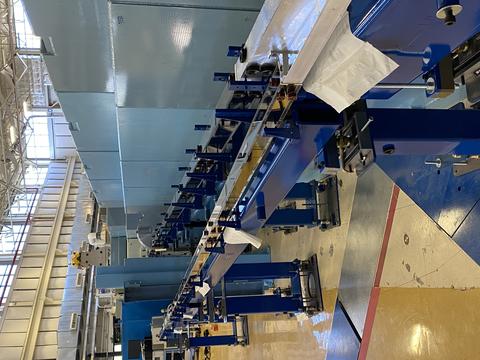
It is hard to find a better note with which to end this post than that stated above regarding the potential continued industrial impact of NDP. However, there is one — at least for me professionally and all our collaborators. In 2019, NIST made a significant investment into NIST NDP through the building of a new, NDP-dedicated, cold neutron beamline (figure 3). When combined with the new, soon-to-be installed cold neutron source at the NCNR, the NIST NDP instrument is expected to operate with a more than 20% signal boost. These upgrades will enhance the applicability of NDP to Li-ion battery research and make it more broadly useful to other research fields such as catalysis (the speeding up of chemical reactions) and different applications such as digital memory devices. With this investment, and like its new beamline, the future for NIST NDP and associate program seems bright.
About the author
Related Posts
Comments
Hi Chris! Thank you for the kind words. I am glad you enjoyed the post.
Sigh, Boring.......
We question; how can this be used in the built world, ie building sciences, materials, fir embodied energy ? Thanks
Hi Robert. Thank you for reading the post and commenting. NDP is very sensitive to boron, which is used to make flame retardants and pest repellants for lumber and plywood. If you are interested in chatting more about this please email me at https://www.nist.gov/people/jamie-weaver.
Is it possible to come to you for an excursion?
A fantastic post!I have some questions about this NDP setup. While reading the Neutron Depth Profiling: Overview and Description of NIST Facilities,i noticed that in chapter New Capabilities mentioned some functionalities will be added in future. Like: cooling the detectors and sputter cleaning the sample surfaces. I wonder to know are these features already implemented? Thanks






It is a rare and special gift to be able to take a subject such as this and turn it into a concept that people can understand. Dr. Weaver does an excellent job of taking a subject that people are not even aware of the fact they are interested in it until it is explained like cookies. I found the information interesting while at the same time making me hungry. :) The skill she has for this visualization is what is so important in getting people interested in science and technology. By putting the subject on a level that does not alienate the reader but allows them the ability to comprehend the material is a key. Well done.